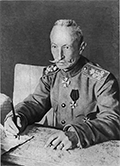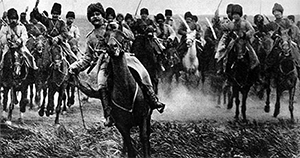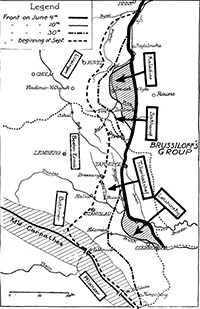The Brusilov Offensive
The Brusilov Offensive was the largest and most successful Allied operation of the First World War. Russian troops attacked along a wide line, resulting in a broad retreat of Austro-Hungarian forces and the loss of more than 1 million men. Confrontations between Germany and Russia in the first two years of the war were largely one-sided. The Battle of Tannenberg, in the early days of the war, was a particularly sharp German victory. In Galicia, as well, Russian troops had to give way in the face of a determined assault, in May 1915. But Russia was still in the war in 1916, and Russian troops still had large numbers to put in the field. When the German Army attacked Verdun in February 1916, the French government implored its allies to attack Germany elsewhere, to pull German troops away. United Kingdom commanders were putting the finishing touches on their strategy for what would be come the First Battle of the Somme. Russian commanders promised to attack in the east. 
Russian troops attacked at Lake Narocz in March. The result there was the same as at Tannenberg–convincing German victory. Russian commanders planned their next attack in north, near Vilna, which is now in Poland. At the same time, General Alexei Brusilov convinced the Russian high command to approve his plan to attack in the southwest, targeting Austria-Hungary. To prepare his troops, Brusilov had built full-size replicas of the positions that they were going to attack. Russian air reconnaissance also delivered very accurate maps of where enemy guns were ensconced. As a result, the attack that came had great precision. 
The Brusilov Offensive began on June 4, with a bombardment of the Austrian position at Lutsk, which is now in Ukraine. Brusilov's strategy was to attack along a long line, preventing the enemy from reinforcing against any breakthroughs in the line. The strategy was overwhelmingly successful, partly because the commander had eschewed the familiar pattern of a dayslong bombardment followed by a massive, slow-moving attack, instead keeping the bombardment short and targeted and then launching a massive attack along a very long and wide line. The Russians quickly took Lutsk, narrowly missing an escaping Austrian commander Archduke Josef Ferdinand. In just two days, the Russian army advanced nearly 50 miles through a collapsing Austro-Hungarian defense. Casualties on the defending side were very high, numbering more than 130,000; Russian troops also took 200,000 enemy prisoners and, importantly, tens of thousands of weapons and rounds of ammunition. 
In desperation, the Austro-Hungarian high command asked the German high command for support, and Germany reluctantly pulled some troops from the western front and sent them east. As a result, the French were able to mount a counterattack at Verdun, just before the main British bombardment began at the Somme. Brusilov's forces pressed on, killing and capturing more enemy troops. By September, Russian troops had taken control of nearly 10,000 square miles of enemy territory. When the Brusilov Offensive ended, on September 20, its results numbered 1.5 million enemy casualties. Total Russian casualties numbered in the hundreds of thousands. Neither army could afford to lose that much in manpower or materiel. Austria-Hungary never recovered and was largely a non-factor for the rest of the war, forcing Germany to fight alone on two fronts. Russia did not duplicate that success but still played some part in the eventual defeat of the Central Powers. |
|
Social Studies for Kids
copyright 2002–2025
David White




